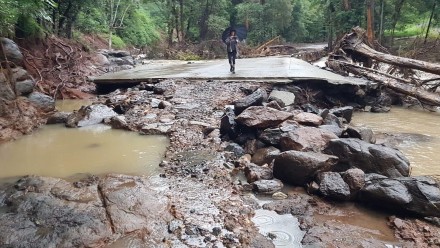ANU researchers team up with Northern Rivers community to build flood resilience
In late February 2022 the Northern Rivers of New South Wales (NSW) experienced a series of extreme rainfall events that led to widespread, catastrophic flooding throughout the region. Vital creek and rainfall gauges, which inform official sources and warning systems, were either broken or transmitting inaccurate data. By contrast, local residents were witnessing and recording clear indications of an emerging flood crisis.
Now, a team of researchers and students from across The Australian National University (ANU) is partnering with local residents in the region to enhance community systems and networks to gather, collate and share flood intelligence data. Entitled The People’s Catchment, the community-led initiative is harnessing ANU expertise to help build community resilience to future extreme floods, which are worsening under the impacts of climate change.
Torrential rans and system failures
In the days leading up to 28 February 2022, a series of severe rain events hit the Northern Rivers region of NSW. The combined impact of the rains created a perilous situation, which was exacerbated by the systematic failure of the official monitoring systems, tasked with predicting flood levels and providing warnings to the community.
“At one point there were four high priority creek gauges out of action as well as crucial rain gauges. There are insufficient creek and rain gauges and those that exist are owned by multiple organisations and some are not properly maintained,” says Annie Kia, a local resident of The Channon and a key driving force behind The People’s Catchment project.
At the same time, local residents with personal rain gauges were recording unprecedented rainfall and witnessing creeks rise to levels never before seen.
“Just north of The Channon, at the headwaters of Terania Creek, a community member measured 930mm [of rainfall] in 18 hours in the upper catchment. But this crucially important information was missed because the official rain gauge up there wasn't working -- it had been dysfunctional for a long time. As a result, the BOM website had no data on this dangerous development”, said Ms Kia.
ANU experts partner on community-led initiatives
Seven people died and thousands were displaced in the ensuing floods. In response, local communities and residents mobilised in an effort to drive improvements in how the region responds to future flooding events.
“The People’s Catchment demonstrates the value of the community-led initiatives to public sector agencies and the critical need for resourcing and institutional change, ” said Dr Roslyn Prinsley, who is Head of Disaster Solutions at the ANU Institute for Climate, Energy and Disaster Solutions and also lead investigator on the project.
Community initiatives underway with The People’s Catchment include a CB UHF radio network for communication when mobile and internet connections fail, a network of local residents - “rain sentinels” - with automatic and manual rain gauges to catch and share real-time data over the whole catchment, and processes to benchmark creek levels for the 2017 and February 2022 floods so that data collected in future high rainfall events is meaningful to those downstream. The methods and technology are being developed and trialled in the Terania-Keerrong sub-catchment.
These initiatives are being supported through a multidisciplinary team of ANU researchers and students, who are providing both technical support and key insights into community efforts. This includes technical advice on rain and creek gauges, idea generation for online sites and apps to share information, and research to explore the systemic issues that led to the lack of flood intelligence during the floods, to share with institutions and organisations. The ANU team is also gaining insights from the community problem-solving, incorporating on-the-ground experiences and knowledge from those who lived through the floods, to inform future disaster responses and solutions.
“Our research with the community is mutually beneficial. ANU has incredible resources, which we are using to benefit communities. We also get much benefit, learning from the community about what works in their environment, for them,” said Dr Prinsley.
The lessons and findings are also being documented and critiqued, to share with other communities faced with similar challenges.
“We need to plan for contingencies, and to emphasise the role of citizens in building more resilient communities in the face of climate change,” said Ms. Kia.
“The passion and drive locals have for this initiative and the collaboration involved is extremely inspiring,” said Dr Prinsley.
“We are working on ways to integrate this information into official systems to improve flood warnings and expect plans for the initiative will lay the groundwork for other at-risk areas across Australia to adopt a similar community-led model to strengthen community preparedness for future floods,” she concluded.











